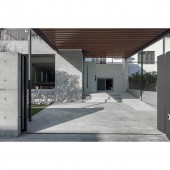DESIGN NAME:
Companionship of Wellbeing
PRIMARY FUNCTION:
Private House
INSPIRATION:
The Designer extends new spaces from a house aged over 40 years, integrating new and old details into harmonious integrity. Valuing the humanity functionalities within the architecture, she plans accessible spaces of flexibility, facilitating the caregiver and the cared for to live under one roof while maintaining each side’s privacy. The subtle and considerate details in the design make for tranquil and peaceful co-housing and companionship of wellbeing.
UNIQUE PROPERTIES / PROJECT DESCRIPTION:
From the good functionality and flexible human housing, Companionship of Wellbeing is an architectural plan creating a living space where caregivers and recipients live together while maintaining privacy. The jabuticaba in the original courtyard was preserved at the corner of a green lawn. The changing of seasons can be enjoyed and savored from indoors. In the post-epidemic era, this space accommodates mixed generations to co-live in the surroundings of nature and thriving greeneries.
OPERATION / FLOW / INTERACTION:
The main concept of the space is the routing of flexibility, flow, and fittingness. Flexibility lies in the possibility of being equipped with new accessibility facilities according to future needs, if any. In the meantime, flow is created by an open space Washitsu in a new fashion, radially stretching out to suit variable needs in life. For the safety and convenience of the residents in this multi-generational house, the floor height differences of more than one meter in the original building, both indoors and outdoors, were all eliminated, and by doing so, the whole space of accessibility was expanded. Furthermore, family units from different generations can perform aged care while achieving variant lifestyles. Last but not least, the fittingness in this accessibility-friendly home allows its residents can actually LIVE effortlessly and autonomously. For caregivers, just like for their attendees, it is a cozy place to live and take care of each other comfortably and conveniently.
PROJECT DURATION AND LOCATION:
The villa sits on the slope of Dadu Plateau, also known as Dadushan Hill, in the suburbs of Taichung in central Taiwan. The project was designed and constructed from 2019 to 2021.
FITS BEST INTO CATEGORY:
Architecture, Building and Structure Design
|
PRODUCTION / REALIZATION TECHNOLOGY:
The choice of concrete is not only out of aesthetics but also functional considerations. It leads to a smooth integration of the inner and outer walls and the beams and columns hidden by the wall slab structure. The ultimate purpose of this production is seeking to retain living space as large as possible on a limited construction base.
SPECIFICATIONS / TECHNICAL PROPERTIES:
Site area: 264㎡ Building area: 144.51㎡
TAGS:
concrete, house, architecture, wood, villa, design, Taichung, Taiwan, wood grain aluminum grille, accessibility, accessible living space, accessible housing, multi-generational housing, interior design, old house renovation
RESEARCH ABSTRACT:
Aspects of design application: Sunlight, air, water, and materials. To solve the natural lighting problem commonly seen in deep parcel houses, for public areas in this house, the window arrangement on the side was preserved, and storage cabinets are embedded in the wall-slab system to prevent sunlight from being blocked. Air: Since it is located on a hillside with a large temperature difference, along with issues caused by monsoon and local air pollution, the styles of the window were considered and changed in the design, with air conditioning and HRV system. Water: The water supply and plumbing systems were re-planned and re-routed, concealed under the floor. On the other hand, water storage systems and groundwater utilization were set up to cope with possible water shortage problems during the dry season. Materials: The building is made with in-suit reinforced concrete, which is easy to maintain and also made the building solid and sturdy.
CHALLENGE:
The most challenging issue is to connect the old and the new structures. The original structure of the old building needs to be reinforced. In addition to dealing with the problematic water leaks in the former aged structure, it is also necessary to prevent future water leakage around the joints and junctions between the old and the new structures. All electricity lines and other pipelines need to be recalculated and replaced. An overall plan for an appropriate deployment should be made for routing and configuration in the newly integrated building. Take the accessibility areas, for instance, spaces under the elevated part are perfect places for new pipelines such as water supply, drainage, sewage, etc., and the spaces above are to accommodate the electricity and air conditioning.
ADDED DATE:
2021-05-30 11:54:58
TEAM MEMBERS (1) :
LIN WEI-CHUN
IMAGE CREDITS:
Lin Wei-Chun, 2021.
|









